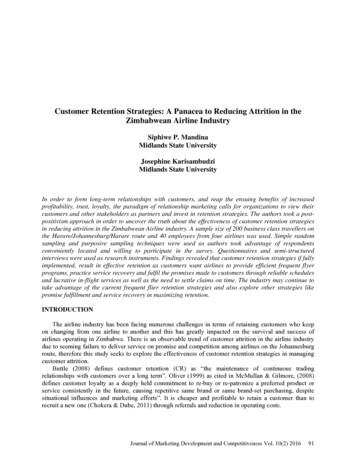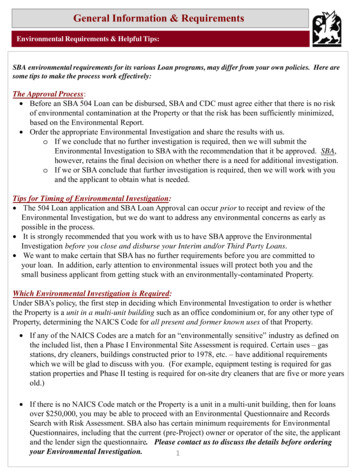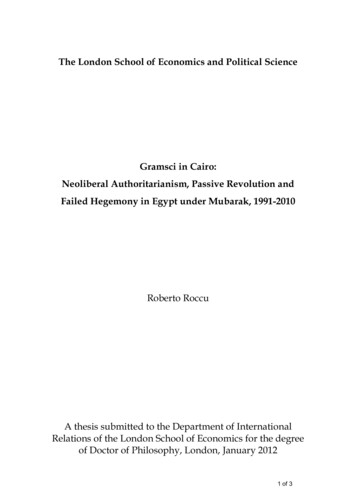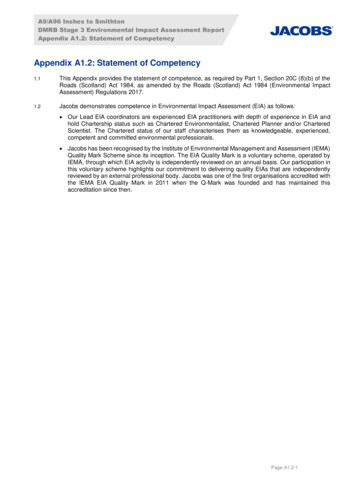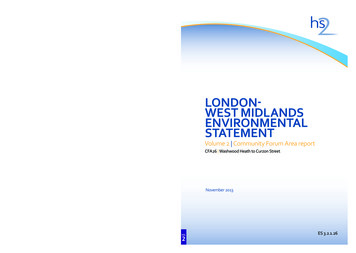
Transcription
LONDON-WEST MIDLANDS ENVIRONMENTAL STATEMENT Vol 2 Community Forum Area report CFA26 Washwood Heath to Curzon StreetVOL VOL VOL222LONDONWEST MIDLANDSENVIRONMENTALSTATEMENTVolume 2 Community Forum Area reportCFA26 Washwood Heath to Curzon StreetNovember 2013ES 3.2.1.26
LondonWest MidlandsENVIRONMENTALSTATEMENTVolume 2 Community Forum Area reportCFA26 Washwood Heath to Curzon StreetNovember 2013ES 3.2.1.26
High Speed Two (HS2) Limited has been tasked by the Department forTransport (DfT) with managing the delivery of a new national high speedrail network. It is a non-departmental public body wholly owned by the DfT.A report prepared for High Speed Two (HS2) Limited:High Speed Two (HS2) Limited,Eland House,Bressenden Place,London SW1E 5DUDetails of how to obtain further copies are available from HS2 Ltd.Telephone: 020 7944 4908General email enquiries: HS2enquiries@hs2.org.ukWebsite: www.hs2.org.ukHigh Speed Two (HS2) Limited has actively considered the needs of blind and partially sightedpeople in accessing this document. The text will be made available in full on the HS2 website.The text may be freely downloaded and translated by individuals or organisations for conversioninto other accessible formats. If you have other needs in this regard please contact High SpeedTwo (HS2) Limited.Printed in Great Britain on papercontaining at least 75% recycled fibre.
CFA Report – Washwood Heath to Curzon Street//No 26 ContentsContents123456Introduction1.1 Introduction to HS21.2 Purpose of this report1.3 Structure of this reportOverview of the area and description of the Proposed Scheme2.1 Overview of the area2.2 Description of the Proposed Scheme2.3 Construction of the Proposed Scheme2.4 Operation of the Proposed Scheme2.5 Community forum engagement2.6 Route section main alternativesAgriculture, forestry and soils3.1 IntroductionAir quality4.1 Introduction4.2 Scope, assumptions and limitations4.3 Environmental baseline4.4 Effects arising during construction4.5 Effects arising from operationCommunity5.1 Introduction5.2 Scope, assumptions and limitations5.3 Environmental baseline5.4 Effects arising during construction5.5 Effects arising from operationCultural heritage6.1 Introduction6.2 Scope, assumptions and limitations6.3 Environmental 101103103103104i
CFA Report – Washwood Heath to Curzon Street/No 26 Contents78910111213ii6.4 Effects arising during construction6.5 Effects arising from operationEcology7.1 Introduction7.2 Scope, assumptions and limitations7.3 Environmental baseline7.4 Effects arising during construction7.5 Effects arising from operationLand quality8.1 Introduction8.2 Scope, assumptions and limitations8.3 Environmental baseline8.4 Effects arising during construction8.5 Effects arising from operationLandscape and visual assessment9.1 Introduction9.2 Scope, assumptions and limitations9.3 Environmental baseline9.4 Temporary effects arising during construction9.5 Permanent effects arising during operationSocio-economics10.1 Introduction10.2 Scope, assumptions and limitations10.3 Environmental baseline10.4 Effects arising during construction10.5 Effects arising during operationSound, noise and vibration11.1 Introduction11.2 Environmental baseline11.3 Effects arising during construction11.4 Effects arising during operationTraffic and transport12.1 Introduction12.2 Scope, assumptions and limitations12.3 Environmental baseline12.4 Effects arising during construction12.5 Effects arising from operationWater resources and flood risk assessment13.1 Introduction13.2 Scope, assumptions and 1223229229229230233244253253254
CFA Report – Washwood Heath to Curzon Street//No 26 Contents1413.3 Environmental baseline13.4 Effects arising during construction13.5 Effects arising from operationReferencesList of figuresFigure 1: HS2 Phase One route and community forum areasFigure 2: Area Context MapFigure 3: Washwood Heath depot visualisation (looking east)Figure 4: Visualisation of the proposed Curzon Street station (looking east)Figure 5: Curzon Street station east entrance level layoutFigure 6: Curzon Street station platform level layoutFigure 7: Curzon Street station concourse level layoutFigure 8: Curzon Street station: intermodal connectionsFigure 9: Schematic of construction compounds for civil engineering worksFigure 10: Schematic of construction compounds for railway installation worksFigure 11: Indicative construction programmeFigure 12: Business sector composition in Birmingham City and the West MidlandsFigure 13: Employment by industrial sector in Birmingham City and the West t of tablesTable 1: Demolitions at Bromford Tunnel west portal (east) main compound, Bromford tunnelwest portal (central) satellite compound and Bromford tunnel west portal (west) satellitecompound39Table 2: Demolitions at Curzon Street No. 1 viaduct satellite compound, Curzon Street No. 2viaduct satellite compound and Curzon Street No. 3 satellite compound46Table 3: Estimated construction, demolition and excavation waste52Table 4: Operational waste forecast for the Proposed Scheme59Table 5: Protected and/or notable species123Table 6: Landfill sites located in or within 250m of the study area135Table 7: Summary of land quality receptors136Table 8: Summary of baseline CSM for sites which may pose a contaminative risk for theProposed Scheme141Table 9: Summary of potential temporary (construction) land quality effects143Table 10: Summary of permanent (post-construction) effects147Table 11: Resources with likely significant direct effects203Table 12: Significant effect on resources203Table 13: Direct adverse effects on residential communities and shared open areas that areconsidered to be significant on a community basis216Table 14: Train flows and speeds224Table 15: Typical vehicle trip generation for construction compounds in this area235Table 16: Approximate Curzon Street station person trips per mode246iii
CFA Report – Washwood Heath to Curzon Street/No 26 ContentsTable 17: Primary origin and destination of trips boarding and alighting at Curzon Street station247Table 18: Surface Water Features potentially affected by the Proposed Scheme257Table 19: Summary of geology and hydrogeology in Washwood Heath to Curzon Street CFA 258iv
CFA Report – Washwood Heath to Curzon Street/No 26 Structure of the HS2 Phase One EnvironmentalStatementStructure of the HS2 Phase OneEnvironmental StatementThe Environmental Statement (ES) documentation comprises: Non-technical summary (NTS) – which provides a summary in non-technicallanguage of the Proposed Scheme, the likely significant environmental effectsof the Proposed Scheme, both beneficial and adverse, and the means to avoidor reduce the adverse effects; Volume 1: This describes High Speed Two (HS2), and the environmentalimpact assessment process, the approach to consultation and engagement,details of the permanent features and generic construction techniques as wellas a summary of main strategic and route-wide alternatives and localalternatives (prior to 2012) considered; Volume 2: Community forum area reports and map books – 26 reports andassociated map books providing a description of the scheme and ofenvironmental effects in each area; Volume 3: Route-wide effects – provides an assessment of the effects of theProposed Scheme where it is not practicable to describe them within the CFAdescriptions in Volume 2; Volume 4: Off-route effects – provides an assessment of the off-route effectsof the Proposed Scheme; Volume 5: Appendices and map books – contains supporting environmentalinformation and associated map books; and Glossary of terms and list of abbreviations – contains terms and abbreviations,including units of measurement, used throughout the ES documentation.1
CFA Report – Washwood Heath to Curzon Street/No 26 Structure of the HS2 Phase One EnvironmentalStatement2
CFA Report – Washwood Heath to Curzon Street/No 26 Introduction1Introduction1.1Introduction to HS21.1.1High Speed Two (HS2) is a new high speed railway proposed by the Government toconnect major cities in Britain. Stations in London, Birmingham, Leeds, Manchester,South Yorkshire and the East Midlands will be served by high speed trains running atspeeds of up to 360kph (225mph).1.1.2HS2 is proposed to be built in two phases. Phase One, the subject of this ES, willinvolve the construction of a new railway line of approximately 230km (143 miles)between London and Birmingham. Construction will begin in 2017 and the line willbecome operational by 2026; with a connection to the West Coast Main line (WCML)near Lichfield and to the existing HS1 railway line in London.1.1.3During Phase One beyond the dedicated high speed track, high speed trains willconnect with and run on the existing WCML to serve passengers beyond the HS2network to destinations in the north. A connection to HS1 will also allow someservices to access that high speed line through east London and Kent and connectwith mainland Europe via the Channel Tunnel.1.1.4Phase Two will involve the construction of lines from Birmingham to Leeds andManchester; with construction commencing approximately 2023, and planned to beoperational by 2033/2024.1.1.5Section 4 of Volume 1 describes the anticipated operational characteristics of HS2,including the anticipated frequency of train services. As Volume 1 shows, thefrequency of trains is expected to increase over time and to increase further uponopening of Phase Two. In assessing the environmental effects of the ProposedScheme the anticipated Phase Two operational frequency has been used. For furtherdetail about operation of the scheme in the Washwood Heath to Curzon Street(CFA26) area, see Section 2.4.1.1.6The Government believes that the HS2 network should link to Heathrow and itspreferred option is for this to be built as part of Phase Two. However, the Governmenthas since taken the decision to pause work on the Heathrow link until after 2015 whenit expects the Airports Commission to publish its final report on recommendedoptions for maintaining the country’s status as an international aviation hub.1.1.7For consultation and environmental assessment purposes, the proposed Phase Oneroute has been divided into 26 community forum areas (CFA), as shown in Figure 1.This has enabled wider public engagement on the scheme design and on the likelyadverse and beneficial effects.1.2Purpose of this report1.2.1This CFA report presents the likely significant effects of the construction andoperation of the Proposed Scheme on the environment within CFA26 (WashwoodHeath to Curzon Street). The report describes the mitigation measures that areproposed for the purpose of avoiding, reducing or managing the likely significantadverse effects of the Proposed Scheme on the environment within CFA26.3
CFA Report – Washwood Heath to Curzon Street/No 26 IntroductionFigure 1: HS2 Phase One route and community forum areas4
CFA Report – Washwood Heath to Curzon Street/No 26 Introduction1.3Structure of this report1.3.1This report is divided into the following sections: Section 1 – an introduction to HS2 and the purpose and structure of this report. Section 2 – overview of the area, description of the Proposed Scheme withinthe area and its construction and operation, and a description of the main localalternatives. Sections 3-13 – an assessment for the following environmental topics:- agriculture, forestry and soils (Section 3);- air quality (Section 4);- community (Section 5);- cultural heritage (Section 6);- ecology (Section 7);- land quality (Section 8);- landscape and visual assessment (Section 9);- socio-economics (Section 10);- sound, noise and vibration (Section 11);- traffic and transport (Section 12); and- water resources and flood risk assessment (Section 13).1.3.2Each environmental topic section comprises: an introduction to the topic; adescription of the environmental baseline within the area; the likely significantenvironmental effects arising during construction and operation of the ProposedScheme; and proposed mitigation measures for any significant adverse effects.1.3.3Environmental effects have been assessed in accordance with the methodology setout in Volume 1, the Scope and Methodology Report (SMR) (see Volume 5: AppendixCT-001-000/1) and the SMR Addendum (see Volume 5: Appendix CT-001-000/2).1.3.4Where appropriate, potential climate change impacts and adaptation measures arediscussed in the relevant environmental topic section. Volume 1 and Section 6A of theSMR Addendum also include additional information about climate change adaptationand resilience.1.3.5The maps relevant to Washwood Heath to Curzon Street are provided in a separatecorresponding document entitled Volume 2: CFA26 Map Book, which should be readin conjunction with this report.1.3.6The Proposed Scheme described in this report is that shown on the Volume 2: MapSeries CT-05 (construction) and CT-06 (operation). There is some flexibility duringdetailed design to alter the horizontal and vertical alignments and other details within5
CFA Report – Washwood Heath to Curzon Street/No 26 Introductionthe limits of deviation shown on the plans and sections submitted to Parliament andas set out in the Bill and this flexibility is included within the scope of theenvironmental assessment. Further explanation is provided in Volume 1, Section 1.4.1.3.76In addition to the environmental topics covered in Sections 3-13 of this report,electromagnetic interference is addressed in Volume 1 and climate (greenhouse gasemissions and carbon), and waste and material resources are addressed in Volume 3.An assessment of potential environmental effects beyond the CFA has also beenundertaken and this 'off-route' assessment is reported in Volume 4.
CFA Report – Washwood Heath/No 26 Overview of the area and description of the Proposed Scheme2Overview of the area and description ofthe Proposed Scheme2.1Overview of the area2.1.1The Washwood Heath to Curzon Street area covers a 5.7km section of the ProposedScheme in Birmingham, to the east of the city centre. It extends from the A4040Bromford Lane in the east to Moor Street Queensway, on the eastern edge ofBirmingham city centre, in the west. The area includes the Birmingham City Council(BCC) wards of Hodge Hill, Washwood Heath, Nechells and Ladywood.2.1.2This area is the most westerly CFA along the route of the Proposed Scheme. CastleBromwich and Bromford (CFA25) lies to the east, as shown in Figure 2.The case for Washwood Heath depot and Curzon Street stationPolicy case2.1.3The case for HS2 is well established within national and regional policy.2.1.4The Department for Transport’s ‘High Speed Rail: Investing in Britain’s Future’1confirmed the choice of Curzon Street as the site for a Birmingham terminus for HS2,best serving passenger requirements including onwards travel, along with theassociated regeneration benefits. It also identifies the need for separate infrastructureand rolling stock maintenance depots at key points along the route, in order for therailway to operate effectively. The Washwood Heath depot is identified as supportingboth Phases One and Two.2.1.5Key local policies are set out within the Birmingham Big City Plan (2010/11),Birmingham Unitary Development Plan (BUDP) 20052, the Birmingham DevelopmentPlan Options Consultation 20123 and the West Midlands Local Transport Plan 20114.The BUDP seeks to integrate transport with development across the Birmingham areaand aims to enhance the wider road, rail and air links to the city taking advantage ofthe development of Birmingham Airport and improvements to the national motorwaynetwork. The Birmingham Development Plan Options Consultation identifies theproposed HS2 route as a key element of the city’s transport infrastructure, helping tobuild upon the success of other improvements to transport infrastructure includingimprovements to Birmingham New Street station.2.1.6Emerging policies are not generally considered within this report, unless a documenthas been submitted to the Secretary of State for approval. The forthcomingBirmingham Development Plan, which will replace the BUDP, is currently underconsultation, it will be submitted to Secretary of State for formal examinationduring 2014.1Department for Transport, (2012), High Speed Rail: Investing in Britain’s Future – Decisions and Next Steps. London, The Stationery Office.Birmingham City Council, (2005), Birmingham Unitary Development Plan.3Birmingham City Council, (2012), Birmingham Development Plan Options Consultation.4Centro, (2011), West Midlands Local Transport Plan.27
CFA Report – Washwood Heath/No 26 Overview of the area and description of the Proposed SchemeWashwood Heath depot2.1.7The area forms part of the city’s core employment area as identified within theemerging Birmingham Development Plan Options Consultation 2012. Thedevelopment of the Washwood Heath depot at this location will result in the lossof employment land.2.1.8As Washwood Heath depot is located at the centre of the national high speed railnetwork in the West Midlands, it will operate as the hub for high speed railmaintenance and operation, supporting both Phase One and Phase Two. Inrecognition of this BCC is currently preparing a development framework for theWashwood Heath depot site to ensure that following the construction of theWashwood Heath depot, economic growth and employment opportunities aremaximised in the local area.Curzon Street station2.1.9Birmingham’s Big City Plan sets out the 20 year vision for transformational changewithin the city centre, and recognises that the Curzon Street station at Eastside willprovide a significant catalyst for regeneration. The Eastside area is a key area ofregeneration and growth within Birmingham’s central core.2.1.10The Draft Eastside Masterplan 20115 recognises the important role the Curzon Streetstation will play in ‘enabling’ regeneration, stating that it will transform Eastside into akey arrival destination, unlocking development opportunities and linking the quarterinto the city centre’s retail and office locations. Furthermore, the masterplan identifiesthat Curzon Square adjacent to the proposed Curzon Street station has the potentialto become a cultural village, building a critical mass of artistic and creative activities.Transport planning case2.1.11The West Midlands Local Transport Plan sets out a way forward to deliver thetransport needs of the West Midlands Metropolitan Area through short, medium andlong-term transport solutions. The West Midlands Local Transport Plan is supportiveof HS2 and seeks to actively promote HS2 with the aim of providing the metropolitanarea with high capacity, fast and reliable connectivity across the UK. This plan seesthis connectivity as providing huge economic benefits to the region by allowingpeople to live and work in a greater range of places across the high speed rail networkwithin the journey to work area, increasing their access to employment opportunities.HS2 therefore has an important role in delivering local transport strategy objectivestowards supporting economic growth, reducing carbon emissions and reducingroad congestion.2.1.12Centro's draft prospectus ‘Towards a World Class Integrated Transport Network’6 setsout the Integrated Transport Authority’s vision for public transport infrastructure inthe region. The prospectus states: “It is essential that the West Midlands is connectedto the European High Speed Rail Network. An international link to BirminghamInterchange and Birmingham city centre HS2 stations will improve economic56Birmingham City Council, (2011), Eastside Masterplan Curzon District.Centro, (2012), Towards a World Class Integrated Transport Network Public Consultation Draft December 2012 – February 2013.8
CFA Report – Washwood Heath/No 26 Overview of the area and description of the Proposed Schemeperformance by increasing European connectivity and providing additional nationalrail capacity”.2.1.13Transport demand forecasts have demonstrated that the majority of the passengerstravelling to and from Birmingham on HS2 would wish to travel to and from thecentral Birmingham terminus at Curzon Street station. This demand (66,000 trips perday) is split between 50% of trips wanting to access origins or destinations withinBirmingham (by car, bus, local rail services, walking or cycling) and 50% of tripsinterchanging to other strategic rail services to access locations outside of theBirmingham urban area.2.1.14Trips forecast to use Curzon Street station and interchange to other strategic railservices will access these services at either of the existing central Birmingham stationsincluding New Street, Moor Street or Snow Hill. These trips will interchange acrossBirmingham city centre between Curzon Street and the other city centre stations.HS2 Ltd will continue to work with Centro to discuss their aspirations for theMidland Metro.Settlement, land use and topography2.1.15The area is entirely urban, with land use comprising light industrial and commercial orinfrastructure through Washwood Heath, Nechells and Saltley. These areas make useof the lower lying land close to the rivers Tame and Rea and also the historicalinfrastructure corridor that follows the valley. Bromford (in CFA25), Washwood Heathand Saltley are the nearest main residential areas, with Gravelly Hill (to the north) andWard End (to the south) are also close by. Pockets of residential development occur inNechells and around Curzon Street station.2.1.16The area has its high point at the western end, where the city centre is, approximately120m above Ordnance Datum (AOD). The ground falls away east along the valleys ofthe River Rea and then the River Tame to approximately 85m AOD at Bromford. Theriver valley is the dominant topographic feature that defines the land use and views inthis area. It is also the basis of the local floodplain and locally important wildlifecorridors.Key transport infrastructure2.1.17The key transport infrastructure in the Washwood Heath to Curzon Street area are therailways, roads and canals that lead to and from Birmingham city centre. Within thisarea, the route will run parallel to the Birmingham and Derby line, the M6 and the A47Heartlands Parkway for most of the route. The Grand Union Canal and the DigbethBranch of the Birmingham and Fazeley Canal (hereafter referred to as the DigbethBranch Canal) are also present in this corridor. Consequently, there are a number oflocally important public highway crossing points over the railway and canal corridorincluding the A4040 Bromford Lane, Aston Church Road, the B4114 Saltley Viaduct(High Street ), Duddeston Mill Road and the A4540 Lawley Middleway.9
CFA Report – Washwood Heath/No 26 Overview of the area and description of the Proposed SchemeFigure 2: Area Context Map10
CFA Report – Washwood Heath/No 26 Overview of the area and description of the Proposed SchemeSocio-economic profile2.1.18To provide a socio-economic context for the area, data is presented for thedemographic character areas (DCA) of Washwood Heath and Curzon Street7. In total,the population of the Washwood Heath and Curzon Street area is approximately20,700; of which Washwood Heath DCA is approximately 9,300 and Curzon StreetDCA is approximately 11,400, which highlights the urban nature of the area. In 2011,the unemployment rate for Washwood Heath DCA was 13% and 8% in Curzon StreetDCA8 compared to West Midlands (9%) and England (7%).Notable community facilities2.1.19No health facilities are directly affected by the Proposed Scheme. Within theimmediate surrounding area are the following health facilities: The DyslexiaAssociation of Birmingham; counselling services at Carrs Lane Church; the HalcyonMedical and Walk-In Centre; and the Sensory Support Service.Recreation, leisure and open space2.1.20Although Birmingham generally has a relatively large amount of public open space,the Nechells and Hodge Hill wards have a deficiency. Four open space areas have beenidentified within close proximity of the Proposed Scheme, including the Grand UnionCanal, the Digbeth Branch Canal, Eastside City Park, and Park Street Gardens.2.1.21There is only one definitive public right of way (PRoW) in the area of the ProposedScheme. The PRoW is not currently accessible, and connects Common Lane toBromford Island, crossing the former Leyland DAF Vans (LDV) factory site inWashwood Heath. There are other footpaths within the wider study area that havebeen referred to in the assessment. The Grand Union Canal and Digbeth Branch Canaltowpaths are other recreational routes close to the Proposed Scheme along withnumerous public highways in the area which provide pedestrian access.Planning contextPlanning Framework2.1.227Given that HS2 is being developed on a national basis to meet a national need it is notincluded or referred to in many local plans, aside from those referred to in theprevious section. Nevertheless, in seeking to consider the Proposed Scheme in thelocal context, relevant local plan documents and policies have been considered inrelation to environmental topics.A DCA represents a community that, depending on the area, may consist of a local ward, neighbourhood or village(s).All data comes from the 2011 Population Census: Office of National Statistics, (2011) Census 2011.811
CFA Report – Washwood Heath/No 26 Overview of the area and description of the Proposed Scheme2.1.23The following local policies have been considered and referred to where appropriateto the assessment. Where a policy document is not referred to within a particulartechnical section, it is due to the absence of policies of relevance to that topic: BUDP is the current adopted development plan for the BCC area; and Birmingham Development Plan Options Consultation (2012) will replace theBUDP once adopted.2.1.24There are a number of key planning designations in the area, which include:conservation areas, listed buildings, scheduled monuments, important archaeologicalsites, and historic parks and gardens. These are shown on Volume 2: Maps CT-10-068bto CT-10-070, and Volume 5: CH-02-156b to CH-02-158-R1.Committed development2.1.25Developments with planning permission or sites allocated in adopted developmentplans, on or close to the Proposed Scheme, are shown in Volume 2: Maps CT-13-068bto CT-13-070 and listed in Volume 5: Appendix CT-004-000.2.1.26It has been assumed that these developments will have been completed by 2017.These are termed 'committed developments' and have been taken into account forthe purpose of assessing the likely significant environmental effects of the ProposedScheme. Where these developments have a particular relevance to an assessmenttopic, this is noted in the future baseline section for that topic. The followingdevelopments are relevant to several topics assessments in this area: planning reference 2012/04578/PA – mixed use development ‘student hub’including formal teaching areas as part of the Birmingham City UniversityCampus at land bounded by Gopsal Street, Cardigan Street, Curzon Street andDigbeth Branch Canal within the Eastside area of the city; planning reference 2007/01816/PA – a mixed use development includingresidential with 353 flats at Bordesley Street, Typhoo Wharf in Digbeth; planning reference 2007/01816/PA – a mixed use development comprising fourbuildings at Masshouse (Plot 7) on land bounded by Dale End, Chapel Street,Moor Street Queensway and Priory Queensway; planning reference 2013/01181/PA – the conversion of a retail unit to fivedwellings as Masshouse Plaza; planning reference 2008/02942/PA – the redevelopment of Eastside Lockscomprising mixed use development including 475 residential units; planning reference 2011/00453/PA – erection of a five storey building foreducation use with associated access, parking and landscaping at CardiganStreet on land adjoining Millennium Point, Eastside; planning reference 2009/00295/PA and 2012/02104/PA – Beorma Quarterdevelopment including refurbishment of existing buildings and construction ofnew buildings for a mixed commercial and leisure development; and planning reference 2012/06883/PA – Permission for change of use and12
CFA Report – Washwood Heath/No 26 Overview of the area and description of the Proposed Schemealterations to the former Central Fire Station to create a mixed usedevelopment including student residential accommodation andcommercial premises.2.1.27Where a committed development lies wholly or partly within the land required for theProposed Scheme, it is assumed that the development will not be commenced orcompleted in its proposed form. Such developments are referred to in the relevanttopic section and noted in Volume 5: Appendix CT-004-000.2.1.28No developments have been identified which are likely to have cumulative effects,when considered together with the Proposed Scheme.2.1.29Planning applications yet to be determined and sites that are proposed allocations indevelopment plans that have yet to be adopted, on or close to the Proposed Scheme,are termed 'proposed developments'. These are listed in Volume 5: Appendix CT-004000. These are not included in the assessment9. The progress of these proposals isbeing monitored by HS2 Ltd.2.2Description of the Proposed Scheme2.2.1The following section describes the main features of the Proposed Scheme in theWashwood Heath to Curzon Street area, including the main environmental mitigationmeasures. Further generic information on typical permanent features is provided inVolume 1, Section 5. Similarly, a general description of the approach to mitigation isset out in Volume 1, Section 9.2.2.2The Proposed Scheme will require some land on a permanent basis, key features ofwhich
CFA Report - Washwood Heath to Curzon Street/No 26 Contents ii 6.4 Effects arising during construction 111 6.5 Effects arising from operation 116 7 Ecology 119 7.1 Introduction 119 7.2 Scope, assumptions and limitations 119 7.3 Environmental baseline 120 7.4 Effects arising during construction 124 7.5 Effects arising from operation 126

